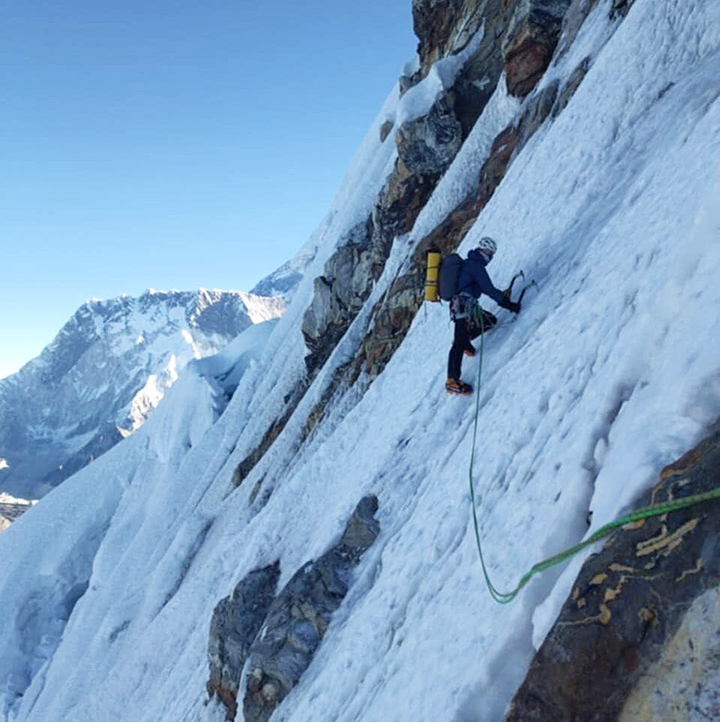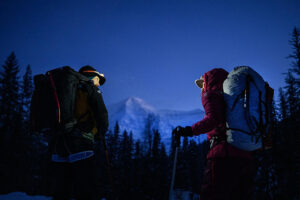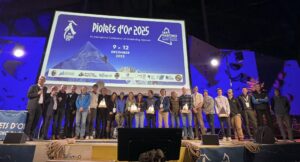On Friday, Mykyta Balabanov and Mykhailo Fomin of Ukraine stood on the summit of Ama Dablam after pioneering a new route up the West Face.
Three years after opening the Southeast Ridge of Annapurna III and a war that shattered their lives, the climbers showed that they have managed to retain their skills, fitness, and willingness to attempt beautiful new lines.
The climbers described their climb to ExplorersWeb from Namche Bazaar today.
“It is a new line up to the shoulder at 6,250m,” Fomin said. “From that point, it follows the British 2001 line to the 6,812m summit. We climbed onsight in a four-day single push,” they noted.
Thus, about 80 percent of their line is new. The climbers propose a difficulty of ED, M5, AI4, 80º for the 1,600m route.
“We had originally planned for three days, but sugary, unstable snow above the shoulder added one more day,” they explained.”
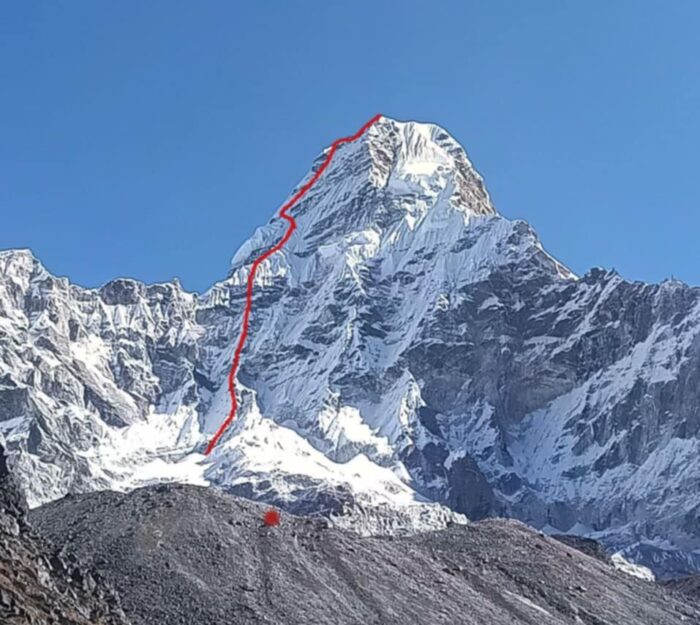
Balabanov and Fomin’s route was new until the final section from the shoulder to the summit. Photo: Mykhailo Fomin
No go on Makalu
The Ukrainians’ original goal this season was a new route on Makalu. However, shortly after reaching Base Camp, they experienced the snowstorms that hit Nepal last month.
“In a day, we had 1.5 meters of fresh snow, and that slowed down the acclimatization process too much,” Fomin noted. “For instance, just moving from Base Camp to Advanced Base Camp, which is usually a short day in running shoes, became a two-day [slog] through deep snow.”
“In such conditions, it soon became clear that we were out of schedule to acclimatize properly for such a technical climb,” Balabanov added. “There was simply no chance.
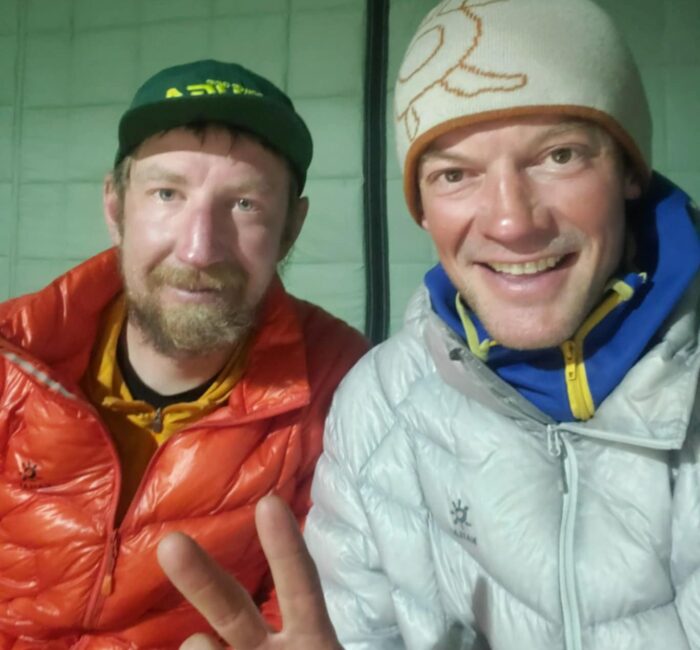
Mykita Balabanov and Mykhailo Fomin of Ukraine, after their successful climb on Ama Dablam. Photo: M. Fomin
They quickly devised a Plan B. They packed their stuff, hired three porters, and set off on foot toward the Khumbu Valley over the Sherpani Col (6,155m) and Amphu Lapcha Pass (5,845 m). Both were overloaded with snow. “Yeah, it was an extra trip to add to the expedition,” the Ukrainians said.
South Face not an option
Ama Dablam was the goal, but the climbers admitted that their first idea was not a new route on the West Face but rather the South Face.
“I had in mind a line that I had seen three years ago,” Balabanov said. “It was not doable in spring [when the face is drier and icier], but I thought perhaps it could be in better condition this fall after the snowfall. I was wrong.”
When they reached the mountain, they went to look at the south side, and their hopes dropped instantly. “The face looked worse than ever,” said Balabanov.
“Global warming has completely changed the conditions on the face, which is more and more dangerous each year,” Fomin noted. “Perhaps it would be possible in winter if there were enough snow, but not now.”
When asked if they were not concerned that someone might steal their idea (it’s happened in some other cases recently), the Ukrainians shrugged.
“Well, good luck with that!” Fomin said.
“Yeah, they can have the idea if they want it, we’re not going to use it,” Balabanov added.

The Ukrainian climbers on the west face of Ama Dablam, as seen from Base Camp. Photo: Seven Summit Treks
Safe, beautiful, unclimbed
With the South Face out of the question, the climbers proceeded to check other options. They quickly spotted a possible route up the West Face.
“It was not an entirely new line, but it was until 6,250m,” Fomin said. “Otherwise, it met all of our expectations. It was safe, it was beautiful, and it was unclimbed.”
The weather was okay, so they went for it the very next day, October 28.
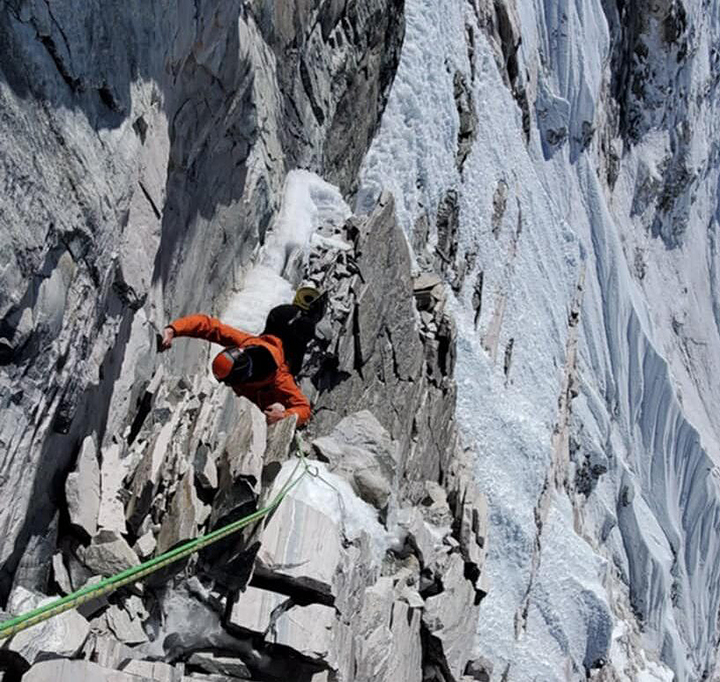
Mixed terrain on the West Face of Ama Dablam. Photo: Fomin/Balabanov
On the lower part, the route follows an obvious feature: a big rib, like a buttress.
“It is not super-technical but rather moderate mixed terrain, with lots of rock climbing, some snow…varied terrain,” Balabanov explained. “After the rib, there is a characteristic rock barrier, which is one of the steepest parts of the route.
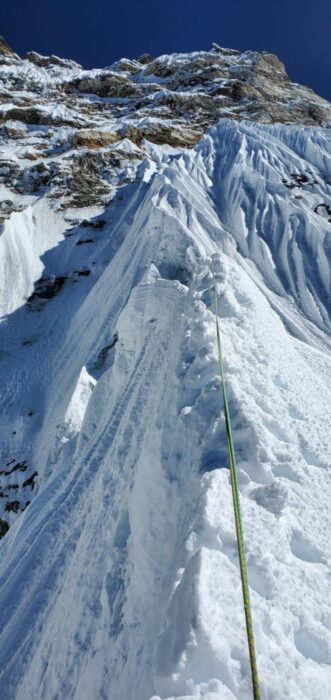
The summit ridge. Photo: Fomin/Balabanov
The one dangerous section
The hardest and most dangerous part of the route lay above the rock barrier.
“This ‘fun’ part of the route was covered in sugary, unstable snow, and it was simply impossible to place any kind of protection,” Balabanov explained.
“It took us an extra day to pass that section of unconsolidated snow,” Fomin added. “For a few hundred meters, all we could do was climb unprotected to the end of the pitch, then dig a hole in the snow with a shovel, sit there, and belay the other climber from that place. When the second climber reached that point, we shifted places, and the other climber would belay from the same hole, knowing the climber above him wouldn’t be placing any protection as he progressed.”
Beginning at the shoulder, the final part of the route consisted of some safer pitches on ice and mixed terrain.
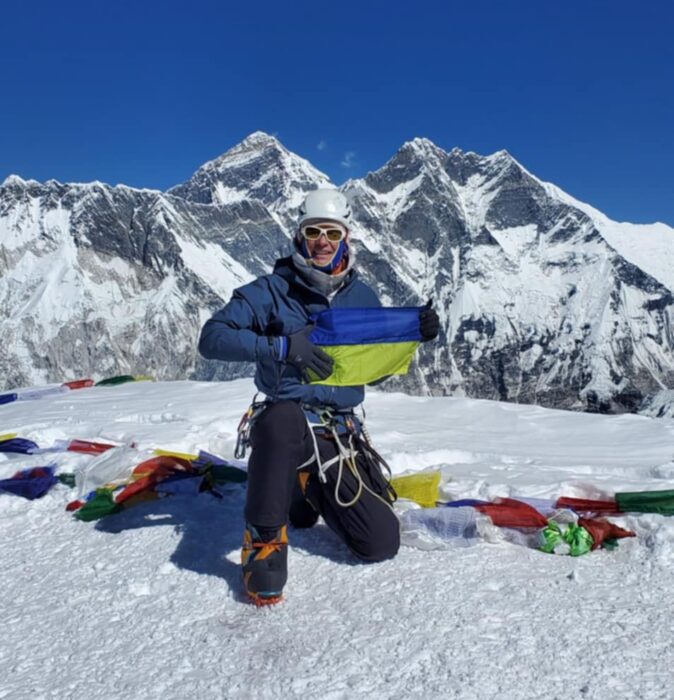
Mykhailo Fomin on the summit. Photo: Mykyta Balabanov
The climbers summited on November 1 and then went down the normal route.
“It was crowded and there were jams on the rappels, but it would have been stupid to go down any other way,” they said. “The normal Southwest Ridge is the most obvious option.”
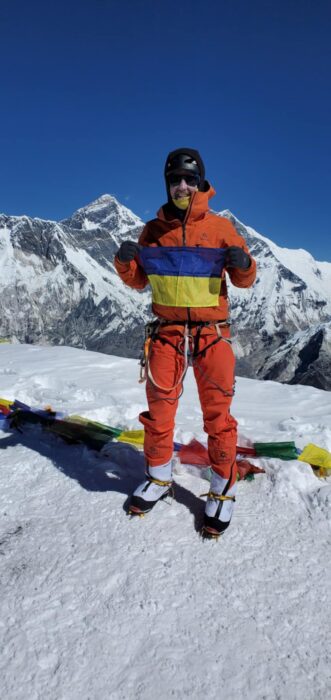
Mykyta Balabanov on the summit. Photo: Mykhailo Fomin
During the climb, the Ukrainians were alone on the West Face. Alexandr Moroz and Mark Ablovacky, the only other team to climb the face this season, had just left. They repeated the American Direct route.
Climbing in a time of war
Returning to the mountains while their country is in a terrible war was a difficult decision for Fomin and Balabanov.
“We thought that even in times of war, our athletes should go to the Olympics,” Fomin said. “They should participate in international competitions, and we should climb again to show that the country is still alive despite all the suffering. Climbing is what we do, and it is our best option to show that Ukraine is still there.”
Yet, the war with Russia is painfully present in their lives. In fact, the day they summited, they learned that a close friend of theirs had died at the front. They named the new route Chegi, his nickname.
“He was one of my best friends, and also my mentor, who taught me everything I know about mountaineering and with whom I had climbed over 100 routes on so many mountains,” Balavanov said.
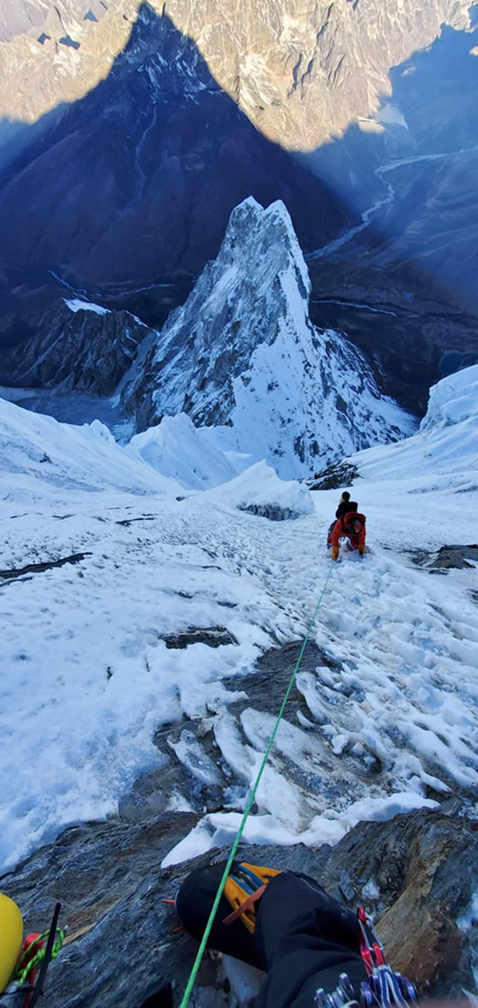
The Ukrainians negotiate a shadowed pitch. Photo: Mykhailo Fomin
